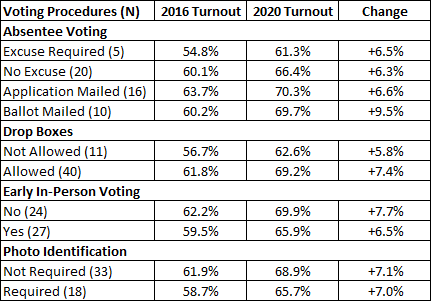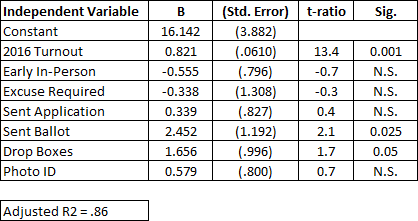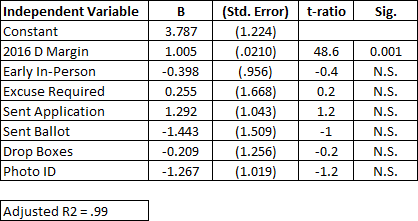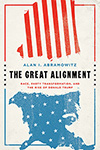Why Voter Suppression Probably Won’t Work
A Commentary By Alan I. Abramowitz
Voting procedures, turnout, and vote margins in the 2020 election.
KEY POINTS FROM THIS ARTICLE
— In the aftermath of the high-turnout 2020 election, many Republican-controlled state governments have passed legislation that Democrats believe will harm their party’s voter turnout.
— However, voting rules did not appear to have much impact on turnout and had no measurable impact on vote margins at the state level in the 2020 presidential election.
— Both voter turnout and voting decisions in 2020 were driven by the strong preferences held by the large majority of voters between the major party candidates.
The limited impact of voting procedure on 2020 turnout
Former President Trump and his political allies continue to push baseless allegations of widespread fraud in the 2020 presidential election more than a year after Joe Biden’s inauguration. Largely in response to those allegations, Republican state legislatures around the country have enacted dozens of laws intended to tighten identification requirements, limit access to absentee voting, reduce the time period for early in-person voting, and limit the use of drop boxes for absentee voting. Democrats have responded to these new laws by proposing legislation in Congress to override these laws but have failed to pass new voting rights laws due to unified Republican opposition and the unwillingness of 2 Democratic senators to modify the filibuster rule in that chamber.
An important question raised by both these new laws and Democratic efforts to override them is just how effective such voter suppression laws would be in reducing voter turnout among Democratic-leaning voter groups. In an earlier article in the Crystal Ball, I examined the impact of expanded absentee voting on the 2020 election. I concluded that increased use of absentee voting had only a small impact on turnout and no effect at all on the Democratic margin in the 2020 presidential election. In this article, I expand my focus to look at the effects of other voting procedures that Republicans have targeted, including increased availability of early in-person voting, use of drop boxes for absentee voting, and stricter identification requirements for absentee and in-person.[1]
The results reinforce the findings of my previous research. These voting rules had only minor effects on turnout and no effect at all on the Democratic margin in the presidential election.
The evidence
Turnout of eligible voters increased in every state and the District of Columbia between 2016 and 2020, with an average increase of just over 7 percentage points. The turnout of roughly 2/3rds of eligible voters in 2020 was the highest in any presidential election in over a century. The percentage of voters casting their ballots before Election Day also increased dramatically as many states adopted policies to encourage both early in-person voting and mail or absentee voting in response to the ongoing coronavirus pandemic. However, there was considerable variability in the policies adopted by the states regarding both early in-person and absentee voting as well as the use of drop boxes and voter ID requirements.
Table 1: State voting procedures and voter turnout in the 2020 election
Note: Early in-person voting does not include early absentee voting in states that mailed absentee ballots to all voters.
Sources: National Conference of State Legislatures, United States Elections Project, FiveThirtyEight, individual state election sources, and research by author.
Table 1 presents data on changes in voter turnout between 2016 and 2020 in relation to absentee voting rules, use of drop boxes, availability of early in-person voting, and photo identification requirements for voting in the states. Turnout here is the estimated percentage of eligible voters casting a ballot in the election. The results show that changes in turnout between 2016 and 2020 were very similar regardless of the voting rules and procedures used by the states. With regard to absentee voting, the only noticeable difference is that the increase in turnout was somewhat greater in the 10 states that mailed ballots directly to voters. The 40 states that allowed the use of drop boxes for absentee voting so that voters did not have to put their ballots in the mail also showed a slightly greater increase in turnout than the 11 states that did not allow the use of drop boxes. There was almost no difference between states with strict photo identification requirements for voting and those without such requirements with regard to increased turnout. Finally, and somewhat surprisingly, states with early in-person voting had a slightly smaller average turnout increase than those that did not have early in-person voting.
In order to determine whether any of these voting rules had a significant effect on turnout in 2020, I conducted a multiple regression analysis with 2020 turnout as the dependent variable and voting rules as the independent variables. I included 2016 turnout as a control variable since there is a high degree of continuity in state voter turnout rates over time — the correlation between 2016 turnout and 2020 turnout was a very strong .906. This means that over 80% of the variation in 2020 turnout is explained by 2016 turnout alone. The results of the regression analysis are displayed in Table 2.
Table 2: Regression analysis of voter turnout in 2020 election
Note: Dependent variable is the turnout of eligible voters in the 2020 election. Omitted category for absentee voting procedures includes 20 states where no excuse was required but applications and ballots were not mailed to voters. Early in-person voting does not include early absentee voting in states that mailed absentee ballots to all voters.
Sources: United States Elections Project, National Conference of State Legislatures, FiveThirtyEight, individual state election sources, and research by author.
The results in Table 2 show that 2016 turnout was by far the strongest predictor of 2020 turnout. However, after controlling for 2016 turnout, the data show that states that mailed absentee ballots directly to voters had a significantly higher turnout in 2020 than other states. Similarly, states that allowed the use of drop boxes for absentee voting had significantly higher turnout than those that required voters to put their absentee ballots in the mail. Finally, early in-person voting had a small negative impact on turnout but this effect was not statistically significant.
It should be emphasized that although some of these effects on turnout are statistically significant, all of them are quite small — no greater than 2 or 3 percentage points. The most important development regarding turnout in the 2020 election is that it increased everywhere and by a rather substantial amount. Voters were highly motivated to participate in the 2020 election, just as they were in the 2018 midterm election before the pandemic hit the United States and many states changed their voting procedures. Turnout surged in 2020 in all types of states regardless of their partisan inclination and regardless of their voting rules.
The other major question about the effects of voting rules and procedures involves their impact on party performance. Did any of these voting procedures favor one party’s candidate over the other party’s candidate? In order to answer this question, I conducted a second regression analysis, this time with the Democratic vote margin in the 2020 presidential election as the dependent variable and various election rules and procedures as independent variables. I included the 2016 vote margin in each state as a control variable because there has been an extremely high degree of continuity in the outcomes of presidential elections at the state level in recent elections. In fact, the correlation of .993 between the Democratic presidential margin in 2016 and the Democratic presidential margin in 2020 was the strongest for any pair of consecutive elections since at least the end of World War II. Almost 99% of the variation in Joe Biden’s margin in 2020 is explained by Hillary Clinton’s margin in 2016.
Table 3: Regression analysis of Democratic vote margin in 2020 election
Note: Dependent variable is Democratic margin in the presidential election. Omitted category for absentee voting procedures includes 20 states where no excuse was required but applications and ballots were not mailed to voters. Early in-person voting does not include early absentee voting in states that mailed absentee ballots to all voters.
Sources: United States Elections Project, National Conference of State Legislatures, FiveThirtyEight, individual state election sources, and research by author.
The results displayed in Table 3 show that after controlling for the Democratic margin in the 2016 election, none of the election rules included in the regression analysis had any discernible impact on the Democratic margin at the state level in 2020. Biden typically ran a few points ahead of Clinton, but whether a state had restrictive or generous absentee voting procedures, conducted early in-person voting, allowed voters to use drop boxes, or required photo identification to vote had no effect on Biden’s margin. In fact, the estimated coefficient for the impact of sending absentee ballots directly to voters, the procedure that has been especially targeted by Donald Trump and his allies as contributing to Biden’s victory, is negative. Biden actually did slightly worse than expected in the 10 states that sent absentee ballots directly to voters, although the coefficient is not close to being statistically significant.
Conclusions
Voting procedures that have been falsely attacked by former President Trump and his political allies for contributing to voter fraud in the 2020 presidential election actually had little impact on voter turnout and no measurable impact on the margin in the presidential election at the state level. Voter turnout increased dramatically in 2020 for reasons that had very little to do with the voting procedures used by different states. Moreover, Joe Biden improved on Hillary Clinton’s performance in 2016 for reasons that had nothing to do with the voting procedures used by different states.
Both voter turnout and voting decisions in 2020 were driven by the strong preferences held by the large majority of voters between the major party candidates. That is very likely to be the case again in the 2022 midterm elections and especially in the 2024 presidential election. Thus, efforts by Republican-controlled state legislatures to suppress turnout by Democratic-leaning voter groups by imposing restrictions on absentee voting, early in-person voting, and use of drop boxes or by requiring that voters present photo identification in order to vote are unlikely to bear fruit. Such efforts could even backfire by angering voters who are the targets of these efforts and by causing left-leaning voting rights groups to increase their voter registration and GOTV efforts.
Footnote
[1] Early in-person voting here does not include states that mailed absentee ballots to all voters even if voters were allowed to return their absentee ballots in person before Election Day.
Alan I. Abramowitz is the Alben W. Barkley Professor of Political Science at Emory University and a senior columnist with Sabato’s Crystal Ball. His latest book, The Great Alignment: Race, Party Transformation, and the Rise of Donald Trump, was released in 2018 by Yale University Press. |
See Other Commentary by Dr. Alan Abramowitz.
See Other Political Commentary.
Views expressed in this column are those of the author, not those of Rasmussen Reports. Comments about this content should be directed to the author or syndicate.
Rasmussen Reports is a media company specializing in the collection, publication and distribution of public opinion information.
We conduct public opinion polls on a variety of topics to inform our audience on events in the news and other topics of interest. To ensure editorial control and independence, we pay for the polls ourselves and generate revenue through the sale of subscriptions, sponsorships, and advertising. Nightly polling on politics, business and lifestyle topics provides the content to update the Rasmussen Reports web site many times each day. If it's in the news, it's in our polls. Additionally, the data drives a daily update newsletter and various media outlets across the country.
Some information, including the Rasmussen Reports daily Presidential Tracking Poll and commentaries are available for free to the general public. Subscriptions are available for $4.95 a month or 34.95 a year that provide subscribers with exclusive access to more than 20 stories per week on upcoming elections, consumer confidence, and issues that affect us all. For those who are really into the numbers, Platinum Members can review demographic crosstabs and a full history of our data.
To learn more about our methodology, click here.




